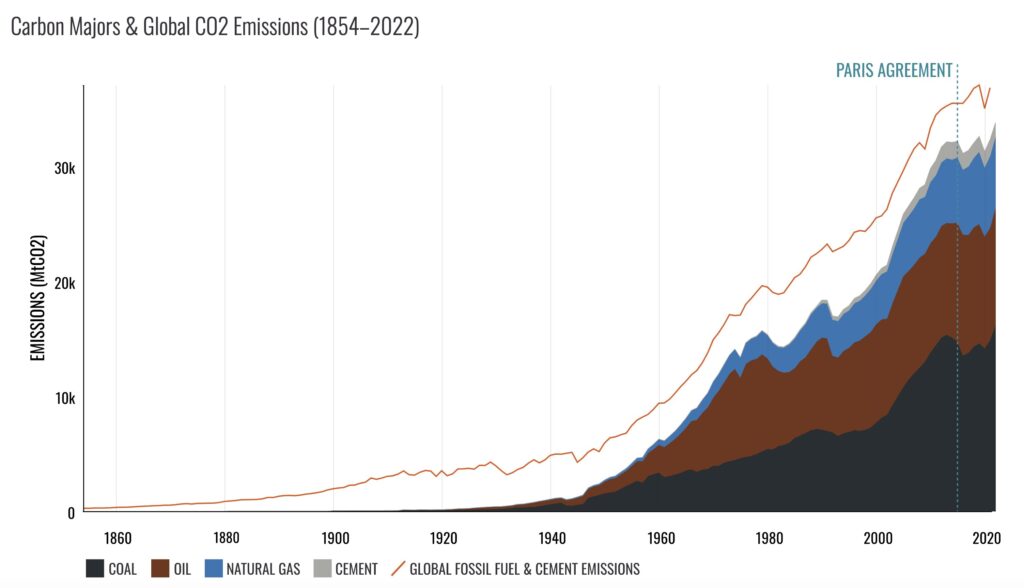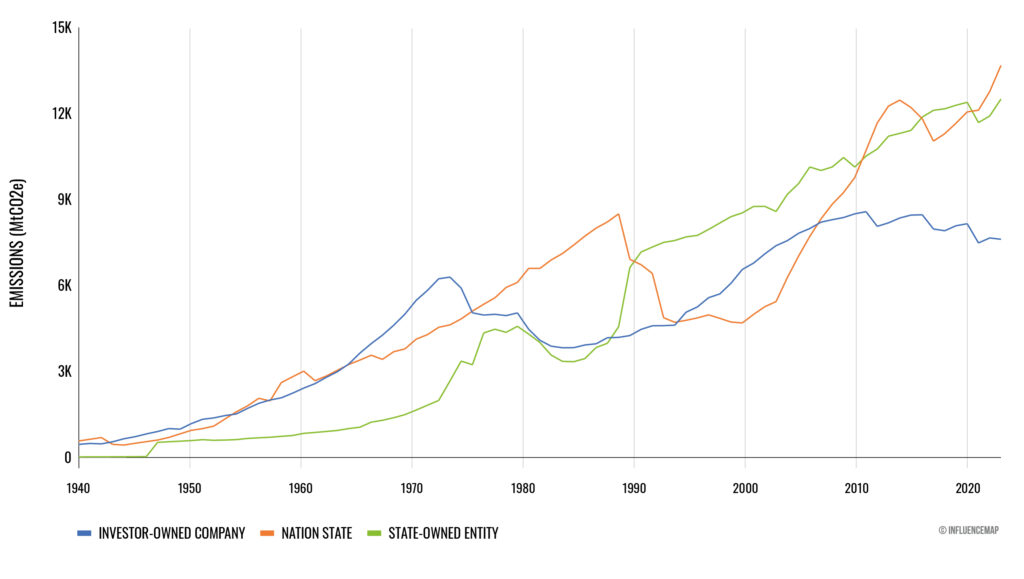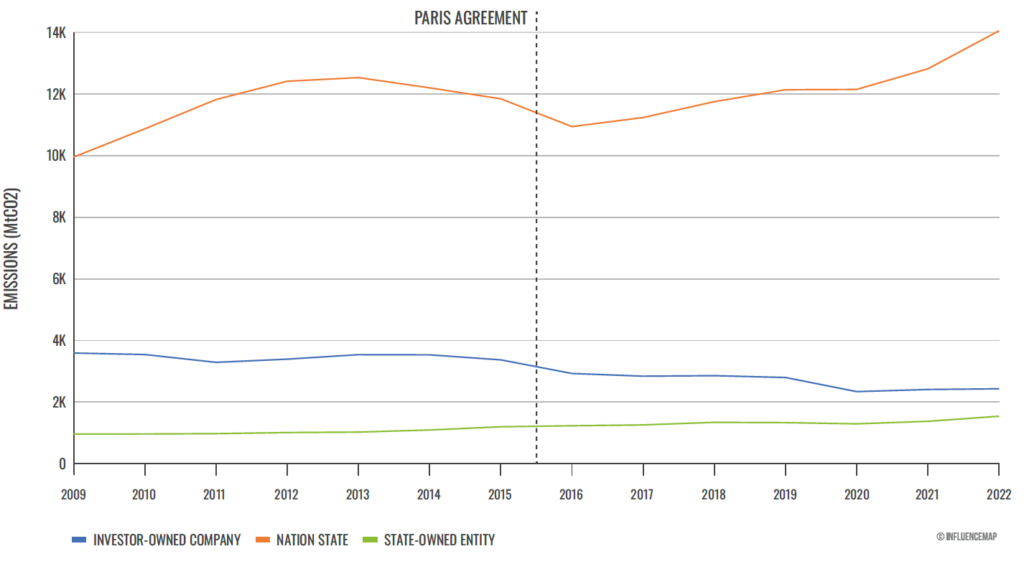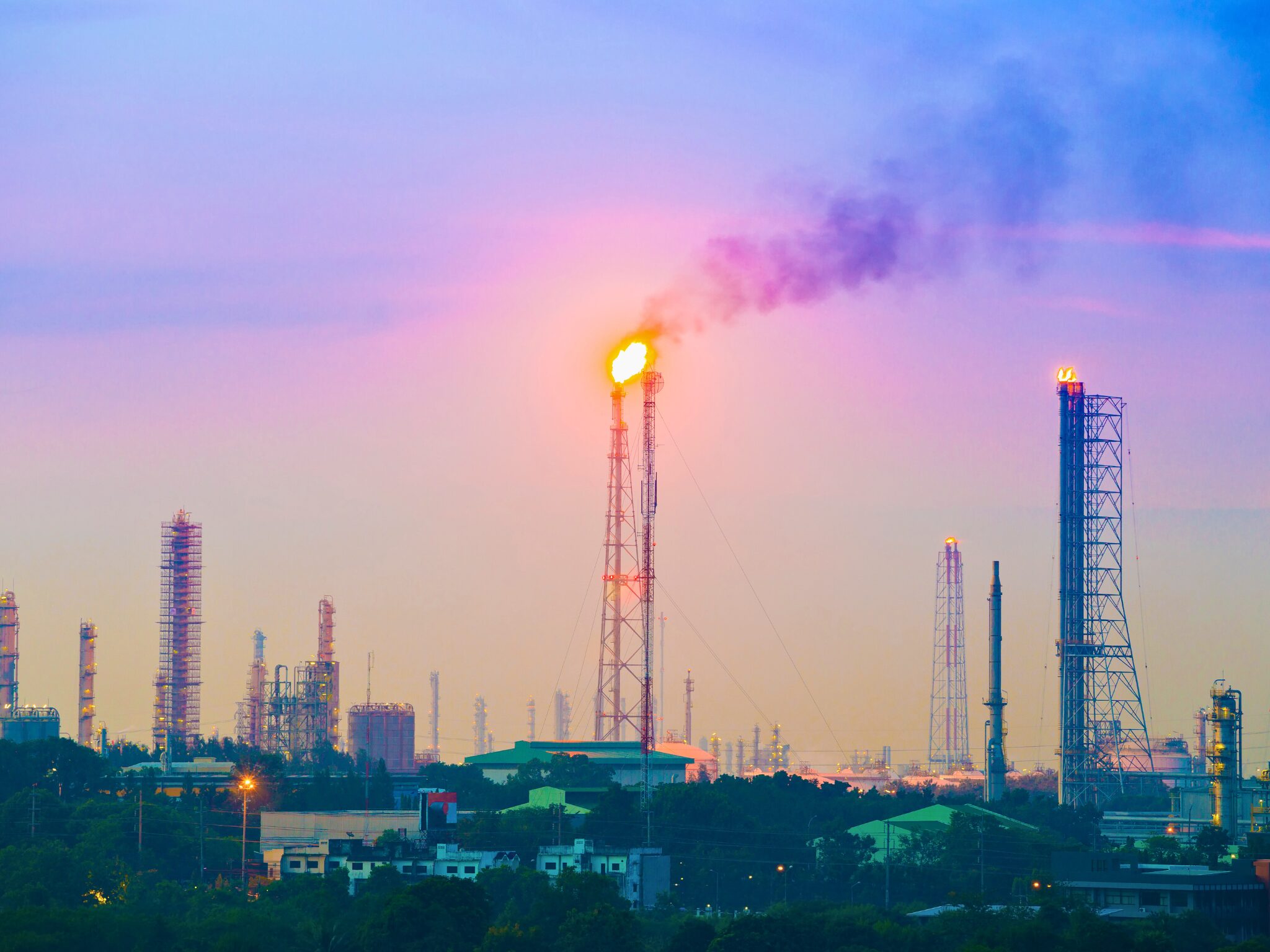Carbon Majors: Fossil Fuel Emissions Have Increased Since the Paris Agreement, With State-Owned Companies in the Spotlight
6 Mins Read
Emissions from the world’s biggest fossil fuel producers were higher in the seven years after the Paris Agreement than in the same period before, with nation-states and state-owned companies responsible for a growing chunk of this figure.
In the seven years after world leaders signed the climate change treaty at COP21 in December 2015 – which has since come to be known as the Paris Agreement – 80% of global greenhouse gas emissions have been directly linked to just 57 companies dealing with oil, gas, coal and cement, according to a new study.
The research is based on the Carbon Majors Database, which has traced historical emissions from 1854 all the way through to 2022 from the world’s biggest polluters, and compared them to more recent developments following the Paris Agreement (from 2016).
Originally launched in 2013 by climate researcher Richard Heede, the database has been an influential tool in shifting the emissions conversation from individuals who use products to the entities that dig fossil fuels to manufacture them. It has been cited in multiple climate and human rights lawsuits, and served as a base for media investigations into the biggest polluters.
The study linked 122 industrial producers to 72% of global fossil fuel and cement carbon emissions since 1751, around the start of the Industrial Revolution, totalling 1,421 gigatonnes. Meanwhile, over 70% of this figure can be traced back to corporate or state entities, highlighting their power and impact on the climate crisis – and just 19 producers contributed to 50% of these CO2 emissions.

Sharp rise in fossil fuel emissions after Paris Agreement
The Carbon Majors Database categorises companies into three ownership types: investors, state-owned and nation-states. Historically, the latter account for 36% of all greenhouse gas emissions tracked, while state-owned companies are responsible for 33%, and shareholder-owned 31%.
Chinese state coal and cement production accounts for 15.3% of historical fossil fuel and cement emissions, while the former Soviet Union comes second on the nation-state list with 6.8%. In terms of state-owned companies, Saudi Aramco is the largest emitter, followed by Gazprom, the National Iranian Oil Company, Coal India, and Pemex, which are cumulatively responsible for 10.9% of these emissions.
Meanwhile, Chevron, ExxonMobil, BP, Shell, and ConocoPhillips are the five largest investor-owned emitters, together contributing to 11.1% of emissions.

However, there has been a shift in coal supply dynamics recently, with shareholder-owned coal production decreasing from 2015 to 2022 (by 28%), and state-owned and nation-state contributions increasing by 19% and 29%, respectively. This is despite warnings from climate experts and committees that fossil fuel production must be curbed if we’re to meet our environmental targets.
The most striking figures come from the seven-year post-Paris Agreement period – from 2016 until the end of 2022 – when most of these companies increased their production of fossil fuels compared to the seven years before the treaty. The study found that 65% of state-owned entities and 55% of private-sector companies had scaled up production in this time.
These seven years contain 12.2% of global fossil fuel CO2 emissions since 1751, in just 2.6% of the time, while six of the 10 highest-emission years have come after the Paris Agreement. In fact, global fossil fuel CO2 emissions increased by 5% from 2015 to 2022, reaching an all-time high of 37.1 gigatonnes. And current estimates suggest that 16% of all carbon emissions since the beginning of the Industrial Revolution were released in the eight years after the Paris Agreement.
Asia and Middle East contributions grow, but US remains top producer

During the post-Paris Agreement period, nation-state entities accounted for 38% of emissions in the database, while state-owned entities were responsible for 37% and investor-owned companies for 25%. The Chinese state coal and cement emissions account for 29% of the total in this period, followed by Saudi Aramco (4.8%), Gazprom (3.3%) and Coal India (3%).
This highlights the shift in fossil fuel power towards Asia and the Middle East, where 20 out of the 25 assessed companies (80%) are linked to higher emissions in the seven years after COP21 than the seven before – the top 10 producers during this period are all based in these two regions. But this emissions rise is also evident in Europe (57% of companies), South America (60%), Australia (75%) and Africa (50%) – all the latter three have a much smaller sample size. North America is the only region where a minority of companies – 16 out of 37, or 43% – are linked to post-Paris Agreement emissions hikes.
However, the US remains the biggest oil and gas producer, the difference being that its contributions are spread between multiple shareholder-owned companies rather than one central state-owned entity. ExxonMobil made up 1.4% of the database’s emissions since 2015, followed by Shell, BP and Chevron (all tied at 1.2%), and TotalEnergies (1%).
These companies have been implicated in several other studies recently – one found that the emissions from fossil fuel burning by these five corporations could lead to 11.5 million premature deaths by 2100, while another graded ExxonMobil among the worst entities on the Carbon Tracker list of fossil fuel companies’ alignment with the Paris treaty.

US president Joe Biden has granted licences to multiple exploration projects, while nearly all companies on the Carbon Tracker list are targeting new developments and production increases in the near term, with Shell among the only ones aiming to keep production volumes flat in the long term, and BP the sole entity planning for a decline by 2030.
In a statement to the Guardian, a Shell spokesperson said: “Shell is committed to becoming a net-zero emissions energy business by 2050, a target we believe supports the more ambitious goal of the Paris agreement to limit global warming to 1.5°C above pre-industrial levels. We continue to make good progress on our climate targets, and by the end of 2023, we had achieved more than 60% of our target to halve Scope 1 and 2 emissions from our operations by 2030, compared with 2016.”
Tzeporah Berman, chair of the Fossil Fuel Non-Proliferation Treaty, said the Carbon Majors Database reveals the offenders responsible for the life- and planet-threatening extreme weather and air pollution we’re seeing. “These companies have made billions of dollars in profits while denying the problem and delaying and obstructing climate policy. They are spending millions on advertising campaigns about being part of a sustainable solution, all the while continuing to invest in more fossil fuel extraction,” she said.
“These findings emphasise that, more than ever, we need our governments to stand up to these companies, and we need new international cooperation through a Fossil Fuel Treaty to end the expansion of fossil fuels and ensure a truly just transition.”



